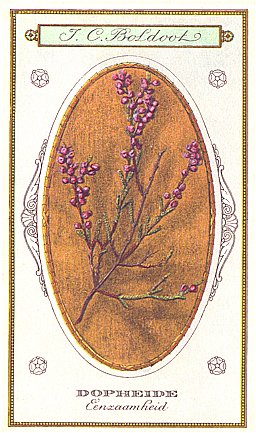



Met deze kaart is iets eigenaardigs aan de hand: er staat "Dopheide" onder, maar het plaatje laat een andere plant zien, nl. Struikheide. Al groeien ze in dezelfde biotoop op dezelfde zure grond, en behoren ze allebei tot de plantenfamilie van de Ericaceae, dit zijn beslist verschillende gewassen! Struikheide (Calluna vulgaris) strekt zich uit in grote min of meer aaneengesloten pollen, en vormt de beroemde paarse heidevelden die men eind augustus tot begin september kan bewonderen, maar dopheide (Erica tetralix) vindt men slechts in kleine groepjes hier en daar temidden van de struikheide. Ik meen dat dopheide ook meer vocht nodig heeft dan struikheide.
Op de foto hierboven (naast de kaart) is dopheide te zien met een paar bloeitakjes struikheide ertussendoor. Waar dopheide groeit, is altijd ook struikheide, maar omgekeerd lang niet altijd. Op de foto hieronder de fijne bloempjes van struikheide - de kleur varieert van licht naar donkerlila, en dit was een wat lichtere struik waarvan de bloempjes mooi tegen de donkere bodem afstaken.
Opmerkelijk is ook, dat de bloempjes op de kaart wat in elkaar geschrompeld zijn, men moet een takje verdroogde heide hebben nagetekend. Vroeger, toen dit nog zonder meer mocht en niet werd verboden door een Flora- en Faunawet waarin allerlei planten als "beschermd" staan gedefinieerd, plukte men in de bloeiperiode een grote bos heide en zette die dan als droogboeket in een vaas, waar het soms het hele jaar bleef staan, uiteraard niet meer zo fris en fleurig als in het begin, maar nog altijd paars, en te houtig om te verleppen. Hierover gaat ook de haiku die ik hieronder bij de gedichten heb geplaatst.
There's something odd about this card: the name says "Dopheide", meaning Cross-leaved heath, while the picture shows us a twig of ordinary heather. Although these grow in the same habitat in the same sour soil, and both belong to the family of Ericaceae, they are quite different plants indeed!
Heather (Calluna vulgaris) grows in vaste areas of more or less linked groups of small shrubs, and forms the famous purple heather-fields you can admire from late August to early September, while Cross-leaved heath (Erica tetralix) grows in small groups of plants within these fields of heather.
In the photo beside the card you see the bells of Crossleaved heath, but some small flowering branches of Heather too. Where you find Crossleaved heath, you always find Heather, but the opposite is not true.
Heather varies from light- to dark-purple. In the photo below a beautiful light-coloured heather plant, contrasting against the dark ground.
It's remarkable too, that the flowers on the card look a bit shrivelled, the drawer's example must have been a dry branch of heather. Formerly, when there was no Flora- and Fauna-law yet, people picked all the flowers they liked, and in the flowering season put a big bunch of heather as a dry bouquet in a vase, where it stayed for the rest of the year. Of coarse it didn't stay as fresh and beautiful, but it remained purple and was too woody to really fade.
The meaning of the Dutch word 'Eenzaamheid' is 'Loneliness'.
Gedichten over heide / Poems about heather :
Droge hei in vaas
op zolder bij mijn Oma -
jeugdherinneringVase with dry heather
in my Grandmother's attic
- childhood memory
Het kindeke van de dood - Frederik Hemkes
Op de grote stille heide (volksliedje)
I never saw a moor - Emily Dickinson (1830-1886)



